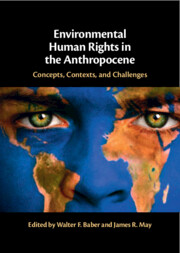Book contents
- Environmental Human Rights in the Anthropocene
- Environmental Human Rights in the Anthropocene
- Copyright page
- Contents
- Contributors
- Acknowledgements
- Introduction
- 1 Framing Environmental Human Rights in the Anthropocene
- 2 Protecting Environmental Human Rights for Future Generations
- 3 Taking Environmental Rights in the Anthropocene Seriously
- 4 The Quest for International Recognition of Environmental Human Rights
- 5 Socioeconomic and Cultural Rights and the Anthropocene
- 6 Local Governments, Climate Action, and Sustainability
- 7 Advancing Environmental Rights through Indigenous Rights
- 8 The Obligation to Curb Carbon Emissions
- 9 Human Rights in the Anthropocene, the Sustainable Development Goals and the Significance of SDG 17, “Partnerships for the Goals”
- 10 The Shape of Environmental Rights Opportunity Structures for the Anthropocene
- Conclusion
- Index
- References
Introduction
Environmental Human Rights in the Anthropocene
Published online by Cambridge University Press: 02 March 2023
- Environmental Human Rights in the Anthropocene
- Environmental Human Rights in the Anthropocene
- Copyright page
- Contents
- Contributors
- Acknowledgements
- Introduction
- 1 Framing Environmental Human Rights in the Anthropocene
- 2 Protecting Environmental Human Rights for Future Generations
- 3 Taking Environmental Rights in the Anthropocene Seriously
- 4 The Quest for International Recognition of Environmental Human Rights
- 5 Socioeconomic and Cultural Rights and the Anthropocene
- 6 Local Governments, Climate Action, and Sustainability
- 7 Advancing Environmental Rights through Indigenous Rights
- 8 The Obligation to Curb Carbon Emissions
- 9 Human Rights in the Anthropocene, the Sustainable Development Goals and the Significance of SDG 17, “Partnerships for the Goals”
- 10 The Shape of Environmental Rights Opportunity Structures for the Anthropocene
- Conclusion
- Index
- References
Summary
The title of this volume applies the increasingly popular concept of the Anthropocene1 to what have come to be known as environmental human rights (EHRs) (Knox et al., 2018; May, 2020; May & Daly, 2014, 2019). At its core, the Anthropocene reflects the idea that the human and non-human elements of the earth system have become so completely intertwined that no change can occur in one without impact on the other (Young et al., 2017). This new state of affairs imposes upon us a responsibility our species has never faced – that of determining both own our fate and the fate of all living things, and the role that law plays in the mix of environmental law and governance (Kotzé, 2017). However, with great responsibility sometimes comes great opportunity. If every environmental challenge is now also a human challenge, it may be that human interests and the interests of the non-human (or, more-than-human) environment are gradually converging (Baber & Bartlett, 2015). If so, then the protection of human rights may afford new opportunities to protect the environment (and vice versa). It remains to be seen whether we are astute enough to recognise those opportunities and take advantage of them.
- Type
- Chapter
- Information
- Environmental Human Rights in the AnthropoceneConcepts, Contexts, and Challenges, pp. 1 - 8Publisher: Cambridge University PressPrint publication year: 2023



